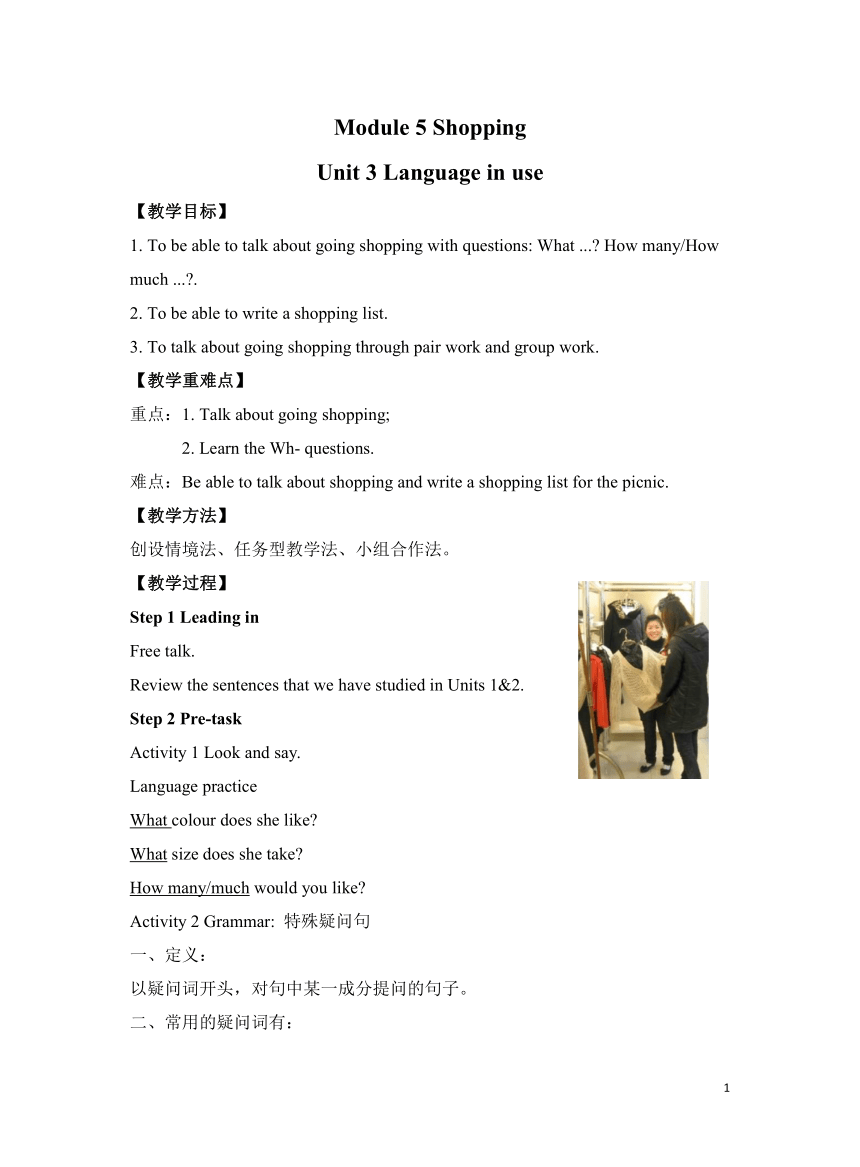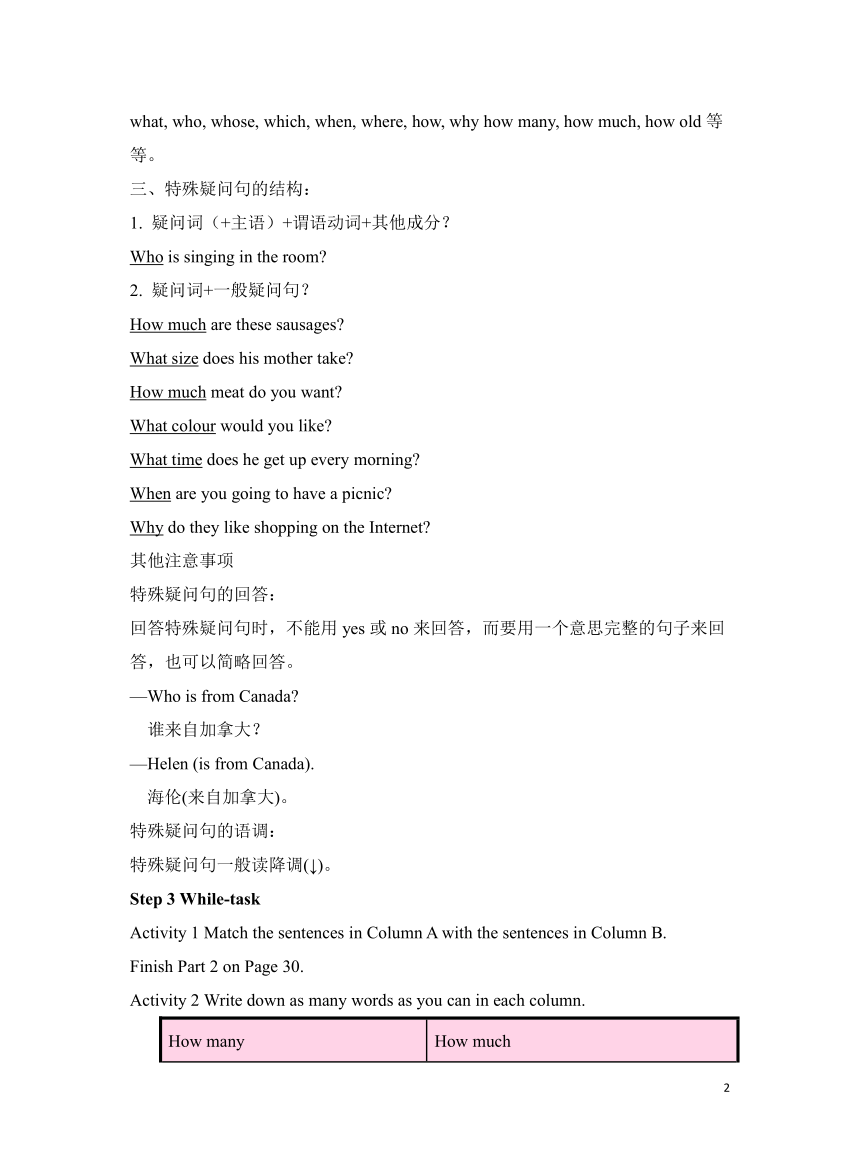初中英语外研版七下Module 5 Shopping Unit3教案
文档属性
| 名称 | 初中英语外研版七下Module 5 Shopping Unit3教案 |

|
|
| 格式 | doc | ||
| 文件大小 | 48.5KB | ||
| 资源类型 | 教案 | ||
| 版本资源 | 外研版 | ||
| 科目 | 英语 | ||
| 更新时间 | 2023-08-30 17:46:58 | ||
图片预览


文档简介
Module 5 Shopping
Unit 3 Language in use
【教学目标】
1. To be able to talk about going shopping with questions: What ... How many/How much ... .
2. To be able to write a shopping list.
3. To talk about going shopping through pair work and group work.
【教学重难点】
重点:1. Talk about going shopping;
2. Learn the Wh- questions.
难点:Be able to talk about shopping and write a shopping list for the picnic.
【教学方法】
创设情境法、任务型教学法、小组合作法。
【教学过程】
Step 1 Leading in
Free talk.
Review the sentences that we have studied in Units 1&2.
Step 2 Pre-task
Activity 1 Look and say.
Language practice
What colour does she like
What size does she take
How many/much would you like
Activity 2 Grammar: 特殊疑问句
一、定义:
以疑问词开头,对句中某一成分提问的句子。
二、常用的疑问词有:
what, who, whose, which, when, where, how, why how many, how much, how old等等。
三、特殊疑问句的结构:
1. 疑问词(+主语)+谓语动词+其他成分?
Who is singing in the room
2. 疑问词+一般疑问句?
How much are these sausages
What size does his mother take
How much meat do you want
What colour would you like
What time does he get up every morning
When are you going to have a picnic
Why do they like shopping on the Internet
其他注意事项
特殊疑问句的回答:
回答特殊疑问句时,不能用yes或no来回答,而要用一个意思完整的句子来回答,也可以简略回答。
—Who is from Canada
谁来自加拿大?
—Helen (is from Canada).
海伦(来自加拿大)。
特殊疑问句的语调:
特殊疑问句一般读降调(↓)。
Step 3 While-task
Activity 1 Match the sentences in Column A with the sentences in Column B.
Finish Part 2 on Page 30.
Activity 2 Write down as many words as you can in each column.
How many How much
Activity 3 Complete the sentences with how much or how many.
1 __________ lemons would you like
2 __________ kilos of sausages do you want
3 __________ coffee do you want
4 __________ boxes of strawberries do you want
5 __________ meat shall I buy
6 __________ milk have you got
Step 4 Post-task
Activity 1 Around the world
Read and answer.
Do you know other ways to go shopping
Activity 2 Work in pairs
Writing a shopping list for a school picnic.
What food do you need
What drinks do you need
How much / many do you need
Activity 3 Exercise.
单项选择
1. —______ will we have our class
—In our classroom.
A. When B. Where C. Which D. How
2. —______ does he do
— He is a manager.
A. What B. Where C. Which D. How
3. _______ do you usually go to school
A. What B. Where C. Which D. How
4. —______ students in your class
—Thirty.
A. How many B. How much C. How old D. How
Step 5 Summary
特殊疑问词并不多,what表示“什么”可组合;
what color 问颜色,what time问时刻。
how 表“怎样”词组多,见面问声How are you
how much 把价问,how many 问数量,记牢莫混淆。
when问时间较模糊,要与what time 区分开;
where“在哪里”,寻找物品莫忘它。
询问原因why常在,回答要用because。
多问问题少出错,句末别忘添问号。
Step 6 Homework
书面表达:
周六,你和同班同学打算去野炊,你们带了很多食物(如:面包、饼干、肉、鸡蛋和蔬菜等)、水果(如:苹果、桔子和草莓等)和饮料(如牛奶、果汁和水)。你们打算唱歌、跳舞和放风筝,你们将玩得很开心。以“A school picnic”为题,写篇80字左右的短文。
【板书设计】
特殊疑问句
一、定义:
以疑问词开头,对句中某一成分提问的句子。
二、常用的疑问词有:
what, who, whose, which, when, where, how, why how many, how much, how old等等。
三、特殊疑问句的结构:
1. 疑问词(+主语)+谓语动词+其他成分?
Who is singing in the room
2. 疑问词+一般疑问句?
注意事项
特殊疑问句的回答:
回答特殊疑问句时,不能用yes或no来回答,而要用一个意思完整的句子来回答,也可以简略回答。
1
Unit 3 Language in use
【教学目标】
1. To be able to talk about going shopping with questions: What ... How many/How much ... .
2. To be able to write a shopping list.
3. To talk about going shopping through pair work and group work.
【教学重难点】
重点:1. Talk about going shopping;
2. Learn the Wh- questions.
难点:Be able to talk about shopping and write a shopping list for the picnic.
【教学方法】
创设情境法、任务型教学法、小组合作法。
【教学过程】
Step 1 Leading in
Free talk.
Review the sentences that we have studied in Units 1&2.
Step 2 Pre-task
Activity 1 Look and say.
Language practice
What colour does she like
What size does she take
How many/much would you like
Activity 2 Grammar: 特殊疑问句
一、定义:
以疑问词开头,对句中某一成分提问的句子。
二、常用的疑问词有:
what, who, whose, which, when, where, how, why how many, how much, how old等等。
三、特殊疑问句的结构:
1. 疑问词(+主语)+谓语动词+其他成分?
Who is singing in the room
2. 疑问词+一般疑问句?
How much are these sausages
What size does his mother take
How much meat do you want
What colour would you like
What time does he get up every morning
When are you going to have a picnic
Why do they like shopping on the Internet
其他注意事项
特殊疑问句的回答:
回答特殊疑问句时,不能用yes或no来回答,而要用一个意思完整的句子来回答,也可以简略回答。
—Who is from Canada
谁来自加拿大?
—Helen (is from Canada).
海伦(来自加拿大)。
特殊疑问句的语调:
特殊疑问句一般读降调(↓)。
Step 3 While-task
Activity 1 Match the sentences in Column A with the sentences in Column B.
Finish Part 2 on Page 30.
Activity 2 Write down as many words as you can in each column.
How many How much
Activity 3 Complete the sentences with how much or how many.
1 __________ lemons would you like
2 __________ kilos of sausages do you want
3 __________ coffee do you want
4 __________ boxes of strawberries do you want
5 __________ meat shall I buy
6 __________ milk have you got
Step 4 Post-task
Activity 1 Around the world
Read and answer.
Do you know other ways to go shopping
Activity 2 Work in pairs
Writing a shopping list for a school picnic.
What food do you need
What drinks do you need
How much / many do you need
Activity 3 Exercise.
单项选择
1. —______ will we have our class
—In our classroom.
A. When B. Where C. Which D. How
2. —______ does he do
— He is a manager.
A. What B. Where C. Which D. How
3. _______ do you usually go to school
A. What B. Where C. Which D. How
4. —______ students in your class
—Thirty.
A. How many B. How much C. How old D. How
Step 5 Summary
特殊疑问词并不多,what表示“什么”可组合;
what color 问颜色,what time问时刻。
how 表“怎样”词组多,见面问声How are you
how much 把价问,how many 问数量,记牢莫混淆。
when问时间较模糊,要与what time 区分开;
where“在哪里”,寻找物品莫忘它。
询问原因why常在,回答要用because。
多问问题少出错,句末别忘添问号。
Step 6 Homework
书面表达:
周六,你和同班同学打算去野炊,你们带了很多食物(如:面包、饼干、肉、鸡蛋和蔬菜等)、水果(如:苹果、桔子和草莓等)和饮料(如牛奶、果汁和水)。你们打算唱歌、跳舞和放风筝,你们将玩得很开心。以“A school picnic”为题,写篇80字左右的短文。
【板书设计】
特殊疑问句
一、定义:
以疑问词开头,对句中某一成分提问的句子。
二、常用的疑问词有:
what, who, whose, which, when, where, how, why how many, how much, how old等等。
三、特殊疑问句的结构:
1. 疑问词(+主语)+谓语动词+其他成分?
Who is singing in the room
2. 疑问词+一般疑问句?
注意事项
特殊疑问句的回答:
回答特殊疑问句时,不能用yes或no来回答,而要用一个意思完整的句子来回答,也可以简略回答。
1
同课章节目录
- Module 1 Lost and found
- Unit 1 Whose bag is this?
- Unit 2 Are they yours?
- Unit 3 Language in use
- Module 2 What can you do ?
- Unit 1 I can play the piano
- Unit 2 I can run really fast
- Unit 3 Language in use
- Module 3 Making plans
- Unit 1 What are you going to do at the weekends?
- Unit 2 We're going to cheer the players.
- Unit 3 Language in use
- Module 4 Life in the future
- Unit 1 Everyone will study at home
- Unit 2 Every family will have a small plane.
- Unit 3 Language in use
- Module 5 Shopping
- Unit 1 What can I do for you?
- Unit 2 You can buy everything on the Internet
- Unit 3 Language in use
- Module 6 Around town
- Unit 1 Could you tell me how to get to the Nationa
- Unit 2 The London Eye is on your right.
- Unit 3 Language in use
- Revision module A
- Module 7 My past life
- Unit 1 I was born in a small village.
- Unit 2 I was born in Quincy.
- Unit 3 Language in use
- Module 8 Story time
- Unit 1 Once upon a time….
- Unit 2 Goldilocks hurried out of the house.
- Unit 3 Language in use
- Module 9 Life history
- Unit 1 He left school and began work at the age of
- Unit 2 He decided to be an actor.
- Unit 3 Language in use
- Module 10 A holiday journey
- Unit 1 What did you do?
- Unit 2 This morning we took a walk.
- Unit 3 Language in use
- Module 11 Body language
- Unit 1 They touch noses!
- Unit 2 Here are some ways to welcome them.
- Unit 3 Language in use
- Module 12 Western music
- Unit 1 It's so beautiful!
- Unit 2 Vienna is the centre of European classical
- Unit 3 Language in use
- Revision module B
